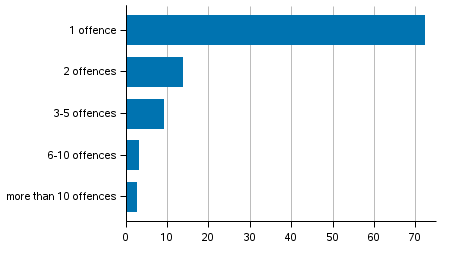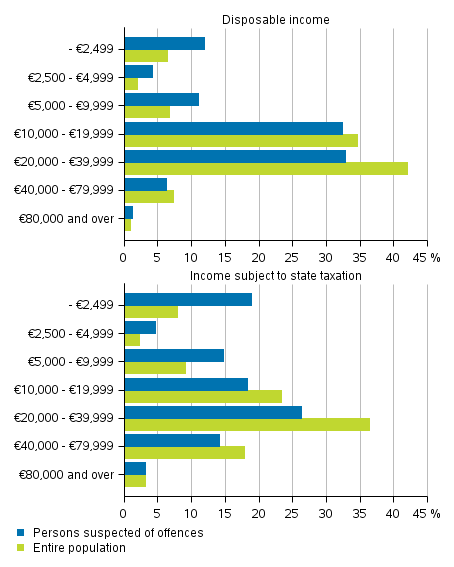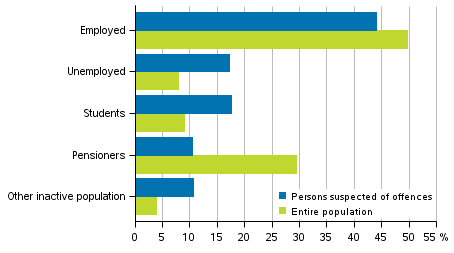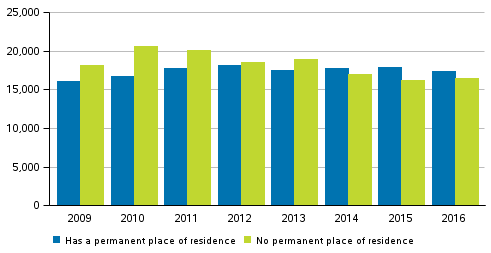2. Persons suspected of solved offences
2.1 Solved offences
During 2016, the police, customs and border guard solved a total of 635,000 offences. The clearance rate was 77.1 per cent, which was 0.2 percentage points lower than in the previous year. Altogether, 285,400 offences against the Penal Code were solved and their clearance rate was 61.1 per cent, which was 1.1 percentage points lower than in 2015. The clearance rate for offences is calculated so that the offences recorded by the police in the statistical reference year and all the offences solved in that same year are compared with each other. For this reason, the clearance rate may be over 100 for some offences.
Among municipalities of over 30,000 inhabitants the clearance rate of offences against the Penal Code was the highest in Kokkola (76.4%), Lappeenranta (76.4%) and Sein�joki (76.0%). The lowest clearance rates were found in Kerava (42.3%); J�rvenp�� (49.8%) and Helsinki (51.4%).
The clearance rate varies by type of offence quite strongly. In all, 37.5 per cent of offences against property and 68.0 per cent of offences against life and health were solved. Due to the manner of disclosure, drunken driving and traffic offences, and offences involving intoxicating substances almost all become solved. In all, 73.1 per cent of frauds (Penal Code, Section 36, Paragraphs 1 to 3) and 83.3 per cent of offences against life were solved. The clearance rate was 67.5 per cent for assault offences.
The clearance rates are the lowest for theft offences (theft, aggravated theft, petty theft), damages to property, means of payment frauds and unauthorised thefts of a motor vehicle. In 2016, fewer than every sixth theft (Penal Code, Section 28, Paragraphs 1 to 2) was solved. In turn, over one-half of petty thefts were solved. Good one-fifth of damages to property and fewer than one-in-ten of means of payment frauds were cleared. One-third of unauthorised thefts of a motor vehicle were solved. Good one-half of robberies were solved.
Table 4. Clearance rate of certain types of offences in 1986-2016
| Offence | 1986 - 1990 | 1991 - 1995 | 1996 - 2000 | 2001 - 2005 | 2006 - 2010 | 2011 - 2015 | 2016 |
| Offences against the Criminal Code | 69 | 58 | 57 | 63 | 67 | 63 | 61 |
| Theft | 25 | 17 | 14 | 16 | 18 | 15 | 15 |
| Aggravated theft | 39 | 29 | 40 | 41 | 38 | 34 | 33 |
| Petty theft | 78 | 70 | 67 | 58 | 57 | 56 | 54 |
| Robbery | 53 | 43 | 42 | 45 | 49 | 54 | 53 |
| Damages to property | 29 | 27 | 27 | 26 | 25 | 22 | 22 |
| Attempted manslaughter, murder or killing | 96 | 91 | 92 | 94 | 97 | 92 | 88 |
| Assault | 79 | 74 | 76 | 80 | 81 | 76 | 67 |
| Aggravated assault | 85 | 84 | 83 | 87 | 88 | 84 | 81 |
| Petty assault | 95 | 86 | 79 | 75 | 73 | 72 | 66 |
| Rape | 63 | 56 | 57 | 63 | 66 | 70 | 67 |
| Sexual exploitation of a child | 91 | 84 | 88 | 82 | 86 | 75 | 69 |
2.2 Persons suspected of offences
In all, 311,100 persons were suspected of the 285,400 solved offences against the Penal Code in 2016. The same person can be a suspect of several different offences. In all, 19.9 per cent of such suspects were women. When calculating according to the most aggravated offence against the Penal Code of a person (a person can be a suspect only one time during the year), 140,100 different persons were suspects. Thus, one person was a suspect of 2.2 offences, on average.
The majority of suspects, 72.1 per cent, were suspects of only one offence in 2016. In all, 13.7 per cent were suspects of two offences. Of the suspects, 14.2 per cent were suspected of more than two offences.
Figure 7. Persons suspected of offences against the Criminal Code by number of offences in 2016

In addition to the quantitative difference, the criminality of men and women differs in that women's shares of assaults, drunken driving and damages to property were small compared to men. However, the share of women suspected of assaults has grown from under ten per cent in 1980 to around twenty per cent. Typical crimes for women were petty thefts, frauds, embezzlements and forgeries. The most common age for both a woman and man suspect was 20 years. The average age of suspected men was 33.7 years and that of women is 34.6 years.
Of persons suspected of solved offences 25 per cent were under the influence of some intoxicant. Of the suspects, 15 per cent were under the influence of alcohol, 8 of some other intoxicant and 2 per cent of alcohol and some other intoxicant. In offences against property, 14 per cent of suspects were under the influence of some intoxicant. In crimes against life and health, 46 per cent and in rapes, 42 per cent of suspects were under the influence of an intoxicant.
Table 5. Suspects of solved offences against the Criminal Code by age and sex in 2007-2016, share per 1,000 population
| Gender/age group | 2007 | 2008 | 2009 | 2010 | 2011 | 2012 | 2013 | 2014 | 2015 | 2016 | |
| Total | Total | 79 | 76 | 72 | 69 | 69 | 64 | 62 | 59 | 58 | 57 |
| Aged under 15 | 12 | 16 | 14 | 13 | 14 | 11 | 10 | 9 | 8 | 8 | |
| Aged 15-17 | 121 | 128 | 123 | 122 | 126 | 109 | 103 | 98 | 91 | 84 | |
| Aged 18-20 | 242 | 239 | 217 | 208 | 214 | 201 | 198 | 185 | 185 | 175 | |
| Aged over 20 | 84 | 79 | 75 | 72 | 71 | 67 | 65 | 63 | 62 | 60 | |
| Male | Total | 131 | 128 | 119 | 115 | 115 | 106 | 102 | 97 | 95 | 92 |
| Aged under 15 | 18 | 23 | 20 | 18 | 20 | 15 | 14 | 13 | 12 | 12 | |
| Aged 15-17 | 201 | 212 | 199 | 194 | 203 | 176 | 167 | 161 | 149 | 135 | |
| Aged 18-20 | 393 | 384 | 343 | 332 | 340 | 320 | 314 | 290 | 292 | 271 | |
| Aged over 20 | 140 | 135 | 127 | 123 | 120 | 112 | 108 | 104 | 102 | 100 | |
| Female | Total | 30 | 26 | 26 | 25 | 26 | 23 | 24 | 23 | 23 | 22 |
| Aged under 15 | 6 | 7 | 7 | 8 | 8 | 6 | 5 | 4 | 4 | 4 | |
| Aged 15-17 | 37 | 40 | 44 | 46 | 47 | 39 | 37 | 33 | 31 | 31 | |
| Aged 18-20 | 83 | 87 | 85 | 79 | 82 | 77 | 77 | 76 | 72 | 73 | |
| Aged over 20 | 32 | 27 | 26 | 25 | 26 | 24 | 25 | 24 | 24 | 23 | |
In 2016, the share of young and under-age people, aged 21 or under, among all suspects of offences against the Penal Code was 17.9 per cent, having been 18.2 per cent one year earlier. The shares of young people were large for alcohol offences, robberies, damages to property, thefts of a motor vehicle, and aggravated endangering of traffic safety. Young people made up 39.7 per cent of persons suspected of robberies, 36.5 per cent of suspects of damages to property and 29.9 per cent of those suspected of aggravated endangering of traffic safety. In all, 19.5 per cent of those suspected of assaults were young people.
2.3 Backgrounds of suspects
The average income subject to state taxation of suspects of offences against the Penal Code aged 15 or over belonging to the registered population (living permanently and temporarily in Finland and with a Finnish personal identity code) was around EUR 24,000, while the corresponding income in total population was about EUR 28,800. Income tax is paid to the state on both earned income and capital income. The corresponding median income was EUR 15,700 and EUR 23,700. Of the suspects, 23.3 per cent had an income of under EUR 5,000, while this was so for 10.2 per cent of the entire population. Among the suspects, 43.4 per cent had an income of at least EUR 20,000, while the share for the entire population was 57.4 per cent. All those whose income subject to state taxation is not known also belong to the group of under EUR 2,499. The figures given in this Section are calculated so that one person is a suspect only one time. The figures calculated here differ from the figures presented elsewhere in this publication where the same person can be a suspect several times during a year. Those guilty of endangerment of traffic safety or traffic infraction were not taken into account in the figures. The data on income subject to state tax of suspects are based on the National Board of Taxes' data in the tax database concerning income subject to state taxation from 2015. In the sections concerning total population, only people permanently resident in Finland were taken into consideration.
Table 6. Persons suspected of offences against the Criminal Code by sex and income (euro) in 2016, aged 15 and over
| Income/sex | Total | - 2,499 | 2,500 - 4,999 | 5,000 - 9,999 | 10,000 - 19,999 | 20,000 - 39,999 | 40,000 -79,999 | 80,000 and over | ||
| Income subject to state taxation | Sex total | Persons suspected | 134,198 | 25,295 | 6,171 | 19,668 | 24,608 | 35,230 | 18,981 | 4,245 |
| % | 100.0 | 18.8 | 4.5 | 14.6 | 18.3 | 26.2 | 14.1 | 3.1 | ||
| Men | Persons suspected | 103,393 | 20,484 | 4,766 | 14,886 | 17,713 | 26,080 | 15,769 | 3,695 | |
| % | 100.0 | 19.8 | 4.6 | 14.3 | 17.1 | 25.2 | 15.2 | 3.5 | ||
| Women | Persons suspected | 30,805 | 4,811 | 1,405 | 4,782 | 6,895 | 9,150 | 3,212 | 550 | |
| % | 100.0 | 15.6 | 4.5 | 15.5 | 22.3 | 29.7 | 10.4 | 1.7 | ||
| Disposable income | Sex total | Persons suspected | 134,198 | 16,073 | 5,678 | 14,870 | 43,452 | 44,076 | 8,446 | 1,603 |
| % | 100.0 | 11.9 | 4.2 | 11.0 | 32.3 | 32.8 | 6.2 | 1.1 | ||
| Men | Persons suspected | 103,393 | 13,314 | 4,616 | 11,978 | 32,705 | 32,327 | 7,015 | 1,438 | |
| % | 100.0 | 12.8 | 4.4 | 11.5 | 31.6 | 31.2 | 6.7 | 1.3 | ||
| Women | Persons suspected | 30,805 | 2,759 | 1,062 | 2,892 | 10,747 | 11,749 | 1,431 | 165 | |
| % | 100.0 | 8.9 | 3.4 | 9.3 | 34.8 | 38.1 | 4.6 | 0.5 | ||
When viewed by disposable money income, the income level of those suspected of offences against the Penal Code was higher. The median of the suspects' disposable income is 82 per cent of that of total population. With income subject to state taxation, the share is 66 per cent. Of the suspects, 16.1 per cent had an income of under EUR 5,000, while according to income subject to state taxation, this group included 23.3 per cent of the suspects. The respective figures for the whole population are 8.5 and 10.2 per cent. Disposable income of over EUR 20,000 was earned by 39.2 per cent of suspects and 50.2 per cent of total population. Disposable income = earned income + entrepreneurial income + property income + current transfers received - current transfers paid. Disposable income is a better measure than income subject to state taxation for describing the actual income of suspects.
Figure 8. Persons suspected of offences against the Criminal Code and the entire population by income subject to state taxation and disposable income in 2016, aged 15 years and over

Classified by main type of activity, 44.1 per cent of the suspects of offences against the Penal Code (belonging to the registered population aged 15 or over) were employed persons. Of all suspects, 17.2 per cent were unemployed and 10.7 per cent in the inactive population. Of the whole population, 49.7 per cent were employed, 7.9 per cent unemployed and 3.9 per cent in the inactive population. The information on main type of activity is from 2014 so it may differ from the current situation.
Figure 9. Persons suspected of offences and the entire population by main activity in 2016, aged 15 and over

Of suspects of offences against the Penal Code aged 15 or over, 42.4 per cent had completed only basic level education and 41.5 per cent upper secondary level education. The respective figures for the whole population were 29.2 and 40.8 per cent.
In Appendix tables 4 to 7, the same person can be a suspect several times. This is a common way to present the number of suspects of offences in the statistics. This produces a better view of criminality as a phenomenon and the backgrounds of the persons guilty of a particular offence can be described better.
2.4 Origin and foreign citizens
The number of persons suspected of offences against the Penal Code solved in 2016 by the police, customs and border guard was 311,100, of whom 33,700 were citizens of foreign countries. Compared to 2015, the number of all suspects of offences against the Penal Code decreased by 3.0 per cent, while the number of foreign citizens suspected went down by 1.1 per cent. The share of foreign nationals in all suspects of offences against the Penal Code was 10.8 per cent. One year earlier, the corresponding share was 10.6 per cent. The share of foreigners among suspects living permanently in Finland was 5.9 per cent. In 2016, Estonians (8,600) and Russians (4,500) made up the biggest group of foreign suspects. Of Estonian suspects, 48.6 per cent and 41.1 per cent of Russians had a permanent place of residence in Finland. Compared with the year before, the number of offences by Estonians decreased by 3.9 per cent and those by Russians by 10.0 per cent. Citizens of the former Soviet Union are also included in Russians.
Other countries where over 1,000 of its citizens were suspected were Iraq (3,200), Somalia (1,400), Sweden (1,800) and Romania (1,500). Of Romanians, only 12.3 per cent had a permanent place of residence in Finland. The respective shares for Somalis and Iraqis were 92.6 and 45.2 per cent. Of Swedes, 49.8 per cent had a permanent place of residence in Finland. In 2015, there were 2,100 Iraqi suspects and 65.3 per cent of them were permanently living in Finland. There were 1,500 Iraqi suspects and 86 per cent of them were living permanently in Finland in 2014. One person can be guilty of many different offences during a year.
Figure 10. Foreign citizens suspected of offences against the Criminal Code by place of residence in Finland in 2009–2016

Among the offences solved in 2016, altogether 51.3 per cent of the suspected foreign citizens were living permanently in Finland. The share was 1 percentage points lower than in 2015. Foreign suspects living in Finland were slightly younger than Finnish suspects were. Their average age was 31 years, while that of Finnish suspects was 32 years. Typical offences by foreigners living in Finland were theft, assault and narcotics offences, as well as driving a motor vehicle without a licence.
In the statistics, the same person can be a suspect several times. Data on the nationality of suspects and on whether they are permanently resident in Finland are based on the nationality data derived from the police and those selected by means of the personal identity code from the population data. The group "no permanent place of residence in Finland" is in that sense problematic, because it may include persons staying longer periods in Finland without applying for a permanent place of residence here. The group may also include persons suspected of a narcotics offence, for example, who have come to Finland only for the purpose of committing a crime. The number of foreign nationals differs somewhat from the figures reported by the police because the police also reports the nationality of the suspect in cases where the investigation is still ongoing. Only solved offences are included in Statistics Finland's figures.
Table 7. Suspects of solved offences against the Criminal Code living in Finland by age and nationality in 2016
| Age group | Suspects living permanently in Finland | Share per 1,000 population in the age group | ||
| Finnish residents | Foreign citizens | Finnish residents | Foreign citizens | |
| -14 | 6,832 | 474 | 7.9 | 13.7 |
| 15-17 | 13,926 | 617 | 81.3 | 109.1 |
| 18-20 | 30,849 | 1,198 | 168.5 | 190.6 |
| 21-24 | 36,994 | 2,028 | 141.7 | 156.9 |
| 25-29 | 38,756 | 3,416 | 123.9 | 114.5 |
| 30-34 | 35,307 | 3,077 | 109.2 | 91.9 |
| 35-39 | 28,336 | 2,310 | 89.1 | 83.0 |
| 40-49 | 39,822 | 2,912 | 63.3 | 74.7 |
| 50-59 | 25,750 | 970 | 35.8 | 41.5 |
| 60-69 | 12,655 | 226 | 17.1 | 20.9 |
| 70- | 5,462 | 73 | 7.4 | 12.0 |
| Total | 274,689 | 17,301 | 52.2 | 75.3 |
Of the 139,200 persons suspected of offences against the Penal Code, 123,700 (88.9 per cent) were of Finnish background. There were 15,200 suspects with foreign background (10.9 per cent). The figures were calculated so that a person is a suspect only one time during the year, which means that this is not the "gross number" of suspects. In the whole population, 93.8 per cent are of Finnish background and 6.2 per cent of foreign background. Of suspects with Finnish background, 2,400 (1.9 per cent) had been born abroad. Of suspects with foreign background, 93.6 per cent had been born abroad. In the review, included are persons belonging to the registered population, that is, people with a Finnish personal identity code. Data on origin are from 2016, so the data on origin of good one two hundred persons were unknown even though they had a Finnish personal identity code. Typically, these persons have moved to Finland in 2016.
Suspects born in Finland with Finnish background numbered 23.8 per 1,000 population with the same origin. In turn, the figure for foreign-born suspects with Finnish background was 47.6. Good one-half of foreign-born persons with Finnish background were born in Sweden. The share of Finnish-born suspects with foreign background per 1,000 population was 18.3 per cent and that of foreign-born persons with foreign background was 49.6 per cent.
Persons suspect of offences against the Criminal Code by origin and share per 1,000 population 2015-2016
| Origin | Suspected | Share per 1,000 population | ||
| 2015 | 2016 | 2015 | 2016 | |
| Origin total | 148,637 | 139,119 | 27.1 | 25.4 |
| Person with Finnish background total | 132,883 | 123,674 | 25.8 | 24.0 |
| Person with Finnish background born in Finland | 130,398 | 121,275 | 25.6 | 23.8 |
| Person with Finnish background born abroad | 2,485 | 2,399 | 49.3 | 47.6 |
| Person with foreign background total | 15,729 | 15,211 | 46.3 | 44.7 |
| Person with foreign background born in Finland | 968 | 974 | 18.2 | 18.3 |
| Person with foreign background born abroad | 14,761 | 14,237 | 51.5 | 49.6 |
| Origin unknown | 25 | 234 | – | – |
A person whose one or both parents were born in Finland is counted as having Finnish background. A person has foreign background if his or her both parents were born abroad. There are more of younger age groups and men among persons with foreign background compared with those with Finnish background. In all, 64.8 per cent of those with foreign background and 45.9 per cent of those with Finnish background are aged under 40.
More details about the origin of suspects by age group and sex is available in the appendix table. The figures are calculated so that one person is a suspect only one time. The figures calculated here differ from the figures presented elsewhere in this publication where the same person can be a suspect several times during a year.
If the number of suspects is calculated so that the same person can be a suspect of several offences against the Penal Code, the number of suspects with Finnish background was 268,500 (86.3 per cent of suspects). Of them, 260,100 were born in Finland and 8,400 abroad. Suspects with foreign background numbered 28,900 (9.3 per cent of suspects). Of persons with foreign background, 2,500 were born in Finland and 26,500 abroad. Among suspects, 0.1 per cent were of unknown origin and 13,400 (4.4 per cent) did not have population information. Population information is missing for tourists and those staying temporarily in the country, for example. Compared with 2015, the number of suspects with Finnish background declined by three per cent and that of suspects with foreign background decreased by 0.7 per cent. The number of Finnish-born suspects with foreign background increased by 9.5 per cent. The number of persons in the group "no population information" grew by 0.8 per cent.
In 2016, a person was suspect of an average of 2.2 solved offences against the Penal Code. Persons with Finnish background born in Finland were suspects of 2.2 offences and persons with Finnish background born abroad of 3.5 offences. Of persons with foreign background, those born in Finland were suspects of 2.5 offences and those born abroad of 1.9 offences.
Source: Statistics on offences and coercive measures 2016, Offences reported. Statistics Finland
Inquiries: Kimmo Haapakangas 029 551 3252, rikos@stat.fi
Director in charge: Jari Tarkoma
Updated 23.3.2017
Official Statistics of Finland (OSF):
Statistics on offences and coercive measures [e-publication].
ISSN=2342-9178. Reported offences, 1st quarter 2016,
2. Persons suspected of solved offences
. Helsinki: Statistics Finland [referred: 20.12.2025].
Access method: http://stat.fi/til/rpk/2016/13/rpk_2016_13_2017-03-23_kat_002_en.html

